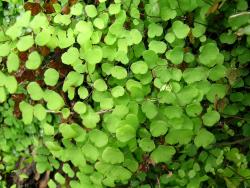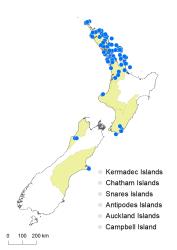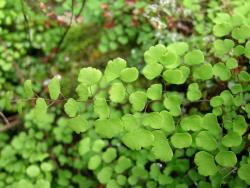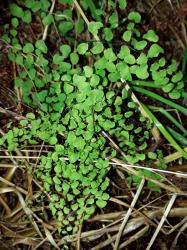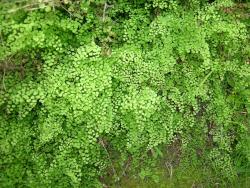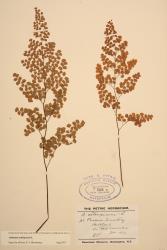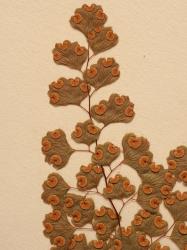- = Adiantum trigonum Labill., Nov. Holl. Pl. 2, 99, t. 248, f. 2 (1807)
Rhizomes erect or very short-creeping, with long-creeping stolons up to 110 mm long and 0.7–1.5 mm diameter (in herbarium material); bearing scales; tubers absent. Rhizome scales narrowly ovate, 1.0–4.0 mm long, 0.2–0.6 mm wide, orange-brown, concolorous. Fronds 125–500 mm long. Stipes 35–330 mm long, dark brown, polished, glabrous except for a few scattered scales proximally. Rachises dark brown, sulcate, polished, glabrous. Laminae 3–4-pinnate, ovate or elliptic, 80–400 mm long, 25–170 mm wide, mid-green on both surfaces, herbaceous, glabrous. 6–12 pairs of divided primary pinnae below pinnate apex, widely spaced especially proximally, ovate; the longest at or below the middle, 27–200 mm long, 12–75 mm wide, apices obtuse, bases stalked, divided into secondary pinnae. 1–6 pairs of secondary pinnae on proximal primary pinnae divided into tertiary pinnae; the longest secondary pinnae ovate, 10–85 mm long, 7–25 mm wide, apices obtuse, bases stalked, divided into tertiary segments. Longest ultimate lamina segments flabellate, broader than long, 4–10 mm long, 6–12 mm wide, apices rounded, margins entire or shallowly incised, bases stalked, with stalks attached centrally. Reflexed lamina flaps reniform, glabrous.
Adiantum aethiopicum is recognised by its 3–4-pinnate fronds, flabellate ultimate segments with the stalks attached centrally, glabrous rachises and laminae, reniform and glabrous “indusia”, and green abaxial lamina surface. The species is easily confused with the naturalised A. raddianum, but distinguished by its ultimate lamina segments, which are broader than long, and either entire or shallowly incised, especially at the point of attachment of the “indusia”. The ultimate segments in A. raddianum are generally longer than broad, and at least some are more deeply incised than the indusial notches, forming two or more distinct lobes. There is a true creeping rhizome in A. raddianum, whereas A. aethiopicum has a more or less erect rhizome with long-creeping stolons.
North Island: Northland, Auckland, Taranaki, Southern North Island.
South Island: Western Nelson, Canterbury.
Altitudinal range: 0–240 m.
Adiantum aethiopicum is common in coastal and lowland areas of the North Island from Te Paki to the Waikato, with outlying populations in Taranaki and southern Wairarapa. It grows from near sea level, reaching 240 m near Unuwhao in Te Paki. In the South Island it has been recorded from the Buller Gorge (AK 135708, WELT P008229). There is also a collection made by J.B. Armstrong from near Akaroa (CHR 633289), an area from which it was also recorded by Raoul (1846, as A. trigonum). However, A. aethiopicum has not been collected anywhere in the South Island since the 19th century.
Also southern Africa, Australia (Western Australia, Northern Territory, South Australia, Queensland, New South Wales, Australian Capital Territory, Victoria, Tasmania), Lord Howe Island and New Caledonia.
Adiantum aethiopicum grows on the ground in open podocarp and broadleaved forest, under mānuka and kānuka, in coastal and gumland scrub, and under pines. It also grows amongst grass or under bracken. It favours coastal cliffs, roadside banks, creek banks, clay slopes, rocky ground, and sometimes swamp margins.
n = 60 (Brownlie 1958).
In contrast to the count of n = 60 in New Zealand populations, 2n = 112 has been reported by Tindale & Roy (2002) in Australian plants of Adiantum aethiopicum, and n = 57 in the related A. atroviride Bostock.
All New Zealand Flora writers since Hooker (1854–1855) have included Adiantum assimile Sw. in the synonymy of A. aethiopicum. Swartz (1801) described the species from an unspecified locality in Australia. Two related species, A. aethiopicum and A. atroviride, are now known to occur in Australia (Bostock 1998), their distributions overlapping in southern Queensland and New South Wales. Bostock (1998) described A. atroviride, but continued to include A. assimile in the synonymy of A. aethiopicum, even though he indicated that he had not seen the type. Without locating the type it is impossible to be certain of its affinities. Unfortunately Swartz’s herbarium in S is currently inaccessible, and the identity of A. assimile must wait until the type can be found and re-examined.



